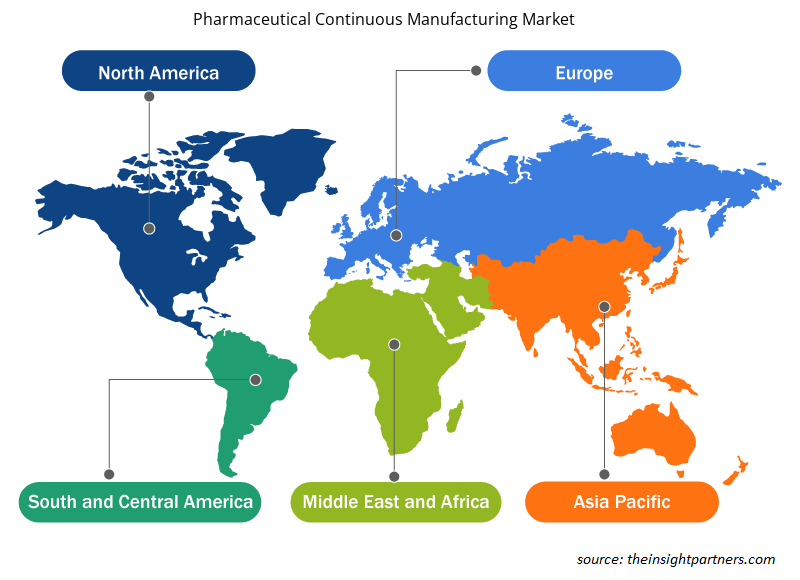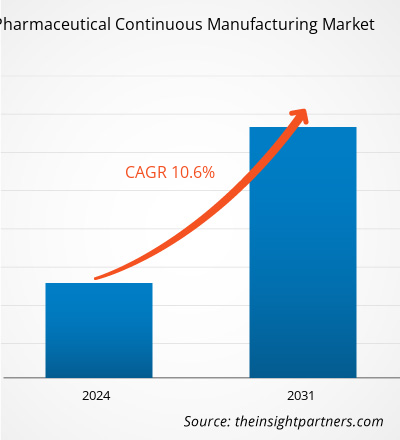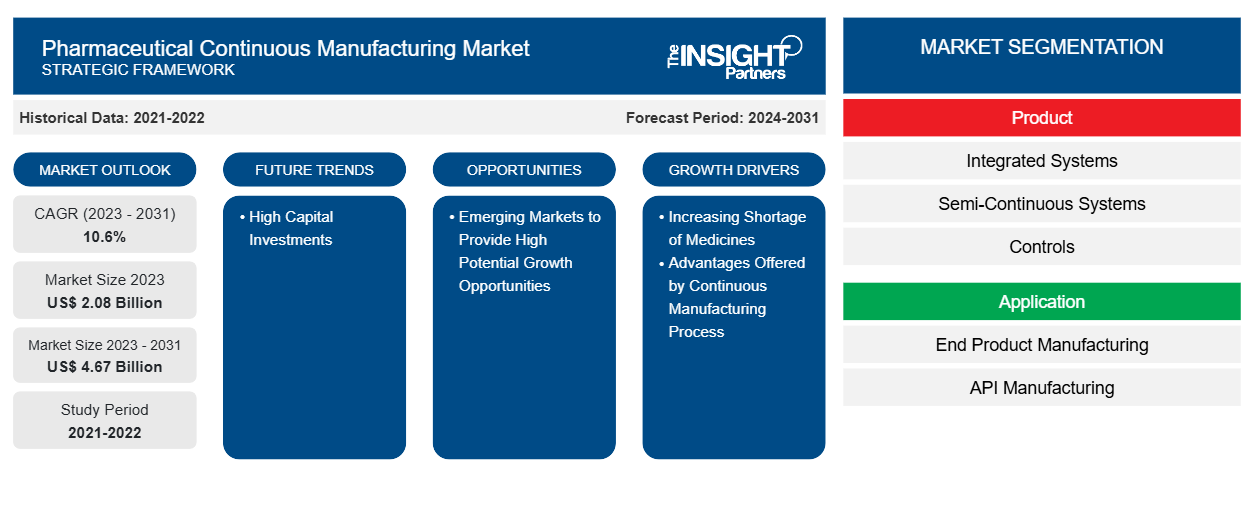Der Markt für kontinuierliche Herstellung pharmazeutischer Produkte soll von 2,08 Milliarden US-Dollar im Jahr 2023 auf 4,67 Milliarden US-Dollar im Jahr 2031 anwachsen. Für den Zeitraum 2023–2031 wird ein durchschnittliches jährliches Wachstum des Marktes von 10,6 % erwartet. Die wachsende Unterstützung durch Regulierungsbehörden, die zunehmende Übernahme von Verfahren zur Arzneimittelherstellung durch Vertrags- und Eigenhersteller sowie die mit der kontinuierlichen Herstellung verbundenen Vorteile werden voraussichtlich weiterhin wichtige Trends auf dem Markt bleiben.
Marktanalyse für kontinuierliche Herstellung pharmazeutischer Produkte
Pharmaunternehmen investieren ständig in innovative Fertigungstechnologien, um Wettbewerbsvorteile zu erlangen und die Nase vorn zu behalten, und treiben damit den Markt für kontinuierliche Fertigung voran. Kontinuierliche Fertigung ermöglicht es den Pharmaunternehmen, ihren Produktionsprozess besser zu kontrollieren, was zur Qualitätsverbesserung und Konsistenz des Endprodukts beiträgt und so Abweichungen und Ausschuss reduziert sowie Nacharbeitszeit und Rückrufkosten spart. Kontinuierliche pharmazeutische Fertigung kann die Qualität des Endprodukts verbessern, die Prozesskontrolle verbessern und Freigabetests in Echtzeit ermöglichen. Die Europäische Arzneimittel-Agentur (EMA) und die US-amerikanische Food and Drug Administration (FDA) sind die Aufsichtsbehörden, die den Einsatz kontinuierlicher Fertigung in der Pharmaindustrie zunehmend befürworten. Darüber hinaus ist kontinuierliche Fertigung in der Pharmaindustrie attraktiver und praktischer geworden, da die verbesserte Prozessüberwachung, -steuerung und -optimierung durch Automatisierung, Systemsteuerung, Datenanalyse und Prozessanalysetechnologie (PAT) ermöglicht wird, die den Markt antreibt.
Marktübersicht zur kontinuierlichen Herstellung pharmazeutischer Produkte
Als praktikable Lösung zur Minimierung des Drucks und zur Reduzierung von Zeit und Kosten bei der Arzneimittelentwicklung bei gleichzeitiger Aufrechterhaltung der Qualität und Versorgung des Endprodukts wird in der Pharmaindustrie häufig die kontinuierliche Fertigung eingesetzt. Aufgrund dieser Vorteile erlebt der Markt für kontinuierliche Fertigung daher ein gesundes Wachstum. Darüber hinaus sind wachsende Initiativen zur Förderung der Verwendung kontinuierlicher pharmazeutischer Fertigungssysteme durch die Food and Drug Administration (FDA) und die zahlreichen Vorteile kontinuierlicher Fertigungssysteme gegenüber der Batch-Fertigung einige der Hauptfaktoren, die das Wachstum des Marktes vorantreiben. Auf der anderen Seite dürfte jedoch die hohe Kosteneffizienz der Implementierung kontinuierlicher pharmazeutischer Fertigungssysteme das Marktwachstum behindern.
Passen Sie diesen Bericht Ihren Anforderungen an
Sie erhalten kostenlos individuelle Anpassungen an jedem Bericht, einschließlich Teilen dieses Berichts oder einer Analyse auf Länderebene, eines Excel-Datenpakets sowie tolle Angebote und Rabatte für Start-ups und Universitäten.
-
Holen Sie sich die wichtigsten Markttrends aus diesem Bericht.Dieses KOSTENLOSE Beispiel umfasst eine Datenanalyse von Markttrends bis hin zu Schätzungen und Prognosen.
Treiber und Chancen auf dem Markt für kontinuierliche Herstellung pharmazeutischer Produkte
Vorteile des kontinuierlichen Herstellungsprozesses begünstigen den Markt
Die kontinuierliche Herstellung von Arzneimitteln wird aufgrund der steigenden Nachfrage nach Biologika und flexiblen Herstellungsalternativen immer beliebter und gewinnt an Bedeutung. Unternehmen, die auf kontinuierliche Herstellungsverfahren umstellen, erhalten schnell die Zulassung der FDA. Der kontinuierliche Herstellungsprozess bietet viele Vorteile, darunter Zeitersparnis, geringerer Energiebedarf und Abfall sowie höhere Produktivität. Darüber hinaus verringert der Prozess das Risiko menschlicher Fehler, da nur wenige Personen am Herstellungsprozess beteiligt sind. Aufgrund der oben genannten Vorteile der kontinuierlichen Herstellung wird erwartet, dass der Markt in den kommenden Jahren wachsen wird.
Schwellenmärkte bieten großes Wachstumspotenzial
In Regionen wie dem asiatisch-pazifischen Raum sowie dem südlichen und zentralen Asien entstehen attraktive Outsourcing-Standorte für die biopharmazeutische Industrie. China und Indien bieten niedrige Herstellungs- und Betriebskosten, die wichtige Faktoren für das Marktwachstum im asiatisch-pazifischen Raum sind. Sowohl China als auch Indien weisen aufgrund des jüngsten Wachstums der biopharmazeutischen Industrie in beiden Ländern positive Zukunftsaussichten für den Markt auf. Im Januar 2020 eröffnete STA Pharmaceutical Co., Ltd., eine Tochtergesellschaft von WuXi AppTec, in China eine neue groß angelegte Produktionsanlage für Oligonukleotid-aktive pharmazeutische Wirkstoffe (API). Daher werden die für die biopharmazeutische Industrie geeigneten Schwellenmärkte wahrscheinlich als Wachstums- und Umsatzgeneratoren mit hohem Potenzial auf dem Markt für kontinuierliche pharmazeutische Herstellung fungieren.biopharmaceutical industry in both countries. In January 2020, STA Pharmaceutical Co., Ltd., – a subsidiary of WuXi AppTec opened a new large-scale oligonucleotide active pharmaceutical ingredient (API) manufacturing facility in China. Thus, the emerging markets suitable for biopharmaceutical industry are likely to act as high potential growth and revenue generators in the pharmaceutical continuous manufacturing market.
Segmentierungsanalyse des Marktberichts zur kontinuierlichen Herstellung von Pharmazeutika
Wichtige Segmente, die zur Ableitung der Marktanalyse für die kontinuierliche Herstellung von Arzneimitteln beigetragen haben, sind Produkt, Anwendung und Endbenutzer.
- Basierend auf dem Produkt ist der Markt für kontinuierliche Herstellung pharmazeutischer Produkte in integrierte Systeme, halbkontinuierliche Systeme und Steuerungen unterteilt. Das Segment der integrierten Systeme hatte im Jahr 2023 den größten Marktanteil und wird im Prognosezeitraum voraussichtlich die höchste durchschnittliche jährliche Wachstumsrate verzeichnen.
- Nach Anwendung ist der Markt in die Herstellung von Endprodukten und die Herstellung von API unterteilt . Das Segment der Endproduktherstellung ist weiter in die Herstellung von Festdosierungen und die Herstellung von Flüssigdosierungen unterteilt. Das Segment der Endproduktherstellung hatte 2023 den größten Marktanteil. Es wird jedoch erwartet, dass das Segment der API-Herstellung zwischen 2021 und 2031 die höchste durchschnittliche jährliche Wachstumsrate verzeichnet.
- Basierend auf dem Endverbraucher ist der Markt für kontinuierliche Herstellung pharmazeutischer Produkte in Großproduktionsunternehmen und F&E-Abteilungen unterteilt. Das Segment der Großproduktion hatte im Jahr 2023 den größten Marktanteil und wird im Prognosezeitraum voraussichtlich die höchste durchschnittliche jährliche Wachstumsrate verzeichnen.
Marktanteilsanalyse für die kontinuierliche Herstellung pharmazeutischer Produkte nach geografischen Gesichtspunkten
Der geografische Umfang des Marktberichts zur kontinuierlichen Herstellung pharmazeutischer Produkte ist hauptsächlich in fünf Regionen unterteilt: Nordamerika, Asien-Pazifik, Europa, Naher Osten und Afrika sowie Süd- und Mittelamerika.
Nordamerika dominiert den Markt für kontinuierliche pharmazeutische Herstellung. Die Faktoren, die zum Wachstum des Marktes für kontinuierliche pharmazeutische Herstellung in Nordamerika führen, sind die wachsende Unterstützung der FDA für die Förderung der kontinuierlichen Herstellung gegenüber der Batch-Herstellung, der zunehmende Mangel an Medikamenten in der Region und die Präsenz von Pharmagiganten, die sich die hohen Anfangsinvestitionen zur Einrichtung kontinuierlicher Herstellungsprozesse leisten können. Die meisten Industrien in den USA setzen seit Jahrzehnten auf kontinuierliche Herstellungsprozesse. Die USA haben eine dominierende Position in Nordamerika aufgrund von Faktoren wie der zunehmenden Zahl von Pharmaunternehmen, die kontinuierliche Herstellungsverfahren anwenden, Fortschritten im Bereich der Fertigungstechnologien und der Effizienz, die diese Systeme bieten, um die Produktionsmengen zu steigern. Darüber hinaus wurden von der US-amerikanischen FDA verschiedene Initiativen ergriffen, um die kontinuierliche Herstellung in den US-amerikanischen Pharmaindustrien zu fördern.
Regionale Einblicke in den Markt für kontinuierliche Herstellung von Arzneimitteln
Die regionalen Trends und Faktoren, die den Markt für kontinuierliche pharmazeutische Herstellung im Prognosezeitraum beeinflussen, wurden von den Analysten von Insight Partners ausführlich erläutert. In diesem Abschnitt werden auch die Marktsegmente und die Geografie der kontinuierlichen pharmazeutischen Herstellung in Nordamerika, Europa, im asiatisch-pazifischen Raum, im Nahen Osten und Afrika sowie in Süd- und Mittelamerika erörtert.

- Erhalten Sie regionale Daten zum Markt für kontinuierliche Herstellung pharmazeutischer Produkte
Umfang des Marktberichts zur kontinuierlichen Herstellung von Arzneimitteln
| Berichtsattribut | Details |
|---|---|
| Marktgröße im Jahr 2023 | 2,08 Milliarden US-Dollar |
| Marktgröße bis 2031 | 4,67 Milliarden US-Dollar |
| Globale CAGR (2023 - 2031) | 10,6 % |
| Historische Daten | 2021-2022 |
| Prognosezeitraum | 2024–2031 |
| Abgedeckte Segmente |
Nach Produkt
|
| Abgedeckte Regionen und Länder |
Nordamerika
|
| Marktführer und wichtige Unternehmensprofile |
|
Marktteilnehmerdichte: Der Einfluss auf die Geschäftsdynamik
Der Markt für kontinuierliche Herstellung pharmazeutischer Produkte wächst rasant. Dies wird durch die steigende Nachfrage der Endverbraucher aufgrund von Faktoren wie sich entwickelnden Verbraucherpräferenzen, technologischen Fortschritten und einem größeren Bewusstsein für die Vorteile des Produkts vorangetrieben. Mit der steigenden Nachfrage erweitern Unternehmen ihr Angebot, entwickeln Innovationen, um die Bedürfnisse der Verbraucher zu erfüllen, und nutzen neue Trends, was das Marktwachstum weiter ankurbelt.
Die Marktteilnehmerdichte bezieht sich auf die Verteilung der Firmen oder Unternehmen, die in einem bestimmten Markt oder einer bestimmten Branche tätig sind. Sie gibt an, wie viele Wettbewerber (Marktteilnehmer) in einem bestimmten Marktraum im Verhältnis zu seiner Größe oder seinem gesamten Marktwert präsent sind.
Die wichtigsten Unternehmen auf dem Markt für kontinuierliche Herstellung von Arzneimitteln sind:
- GEA Group
- Coperion GmbH
- Gericke AG
- Glatt GmbH
- Hosokawa Micron Gruppe
- Munson Machinery Co. Inc.
Haftungsausschluss : Die oben aufgeführten Unternehmen sind nicht in einer bestimmten Reihenfolge aufgeführt.

- Überblick über die wichtigsten Akteure auf dem Markt für kontinuierliche Herstellung von Arzneimitteln
Nachrichten und aktuelle Entwicklungen zum Markt für kontinuierliche Herstellung pharmazeutischer Produkte
Der Markt für kontinuierliche pharmazeutische Produktion wird durch die Erhebung qualitativer und quantitativer Daten nach Primär- und Sekundärforschung bewertet, die wichtige Unternehmensveröffentlichungen, Verbandsdaten und Datenbanken umfasst. Nachfolgend sind einige der Entwicklungen auf dem Markt für kontinuierliche pharmazeutische Produktion aufgeführt:
- Das in Südkorea ansässige Vertragsentwicklungs- und Fertigungsunternehmen (CDMO) SK Bioscience hat mit dem Bau einer etwa 4.200 m2 großen Erweiterung seiner Impfstoffproduktionsanlage L House in Andong, Gyeongsangbuk-do, Südkorea begonnen. Diese soll als Produktionsstandort für den Pneumokokken-Konjugatimpfstoffkandidaten GBP410 dienen, der gemeinsam von SK Bioscience und Sanofi entwickelt wurde, die gemeinsam in die Erweiterung investieren. (SK Bioscience, Pressemitteilung, März 2024)
- Phlow Corp., ein in den USA ansässiges gemeinnütziges Unternehmen für lebenswichtige Arzneimittel, gab strategische Allianzen mit dem Medicines for All Institute der Virginia Commonwealth University (VCU) und AMPAC Fine Chemicals bekannt, um Forschungs- und Entwicklungsdienstleistungen (F&E) für die kontinuierliche Herstellung von niedermolekularen pharmazeutischen Produkten auf Vertragsbasis anzubieten. Zusätzlich zu seinen robusten und wachsenden internen Kapazitäten wird Phlows Netzwerk aus etablierten, innovativen und erfahrenen strategischen Partnern hochwertige, in den USA ansässige fortschrittliche Fertigungslösungen für niedermolekulare pharmazeutische Wirkstoffe (APIs) und registrierte Ausgangsstoffe (RSMs) in allen Entwicklungsphasen unter Verwendung modernster Technologien und einzigartiger Branchenkenntnisse bereitstellen. (Phlow Corp., News, März 2022)
Marktbericht zur kontinuierlichen Herstellung pharmazeutischer Produkte – Umfang und Ergebnisse
Der Bericht „Marktgröße und Prognose für die kontinuierliche Herstellung von Arzneimitteln (2021–2031)“ bietet eine detaillierte Analyse des Marktes, die die folgenden Bereiche abdeckt:
- Marktgröße und Prognose für die kontinuierliche Herstellung von Arzneimitteln auf globaler, regionaler und Länderebene für alle wichtigen Marktsegmente, die im Rahmen des Berichts abgedeckt sind
- Markttrends und Marktdynamiken im Bereich der kontinuierlichen Herstellung von Arzneimitteln, wie Treiber, Einschränkungen und wichtige Chancen
- Detaillierte PEST- und SWOT-Analyse
- Marktanalyse für die kontinuierliche Herstellung von Arzneimitteln, die wichtige Markttrends, globale und regionale Rahmenbedingungen, wichtige Akteure, Vorschriften und aktuelle Marktentwicklungen umfasst
- Branchenlandschaft und Wettbewerbsanalyse, einschließlich Marktkonzentration, Heatmap-Analyse, prominenten Akteuren und aktuellen Entwicklungen für den Markt für kontinuierliche Herstellung pharmazeutischer Produkte
- Detaillierte Firmenprofile
- Historische Analyse (2 Jahre), Basisjahr, Prognose (7 Jahre) mit CAGR
- PEST- und SWOT-Analyse
- Marktgröße Wert/Volumen – Global, Regional, Land
- Branchen- und Wettbewerbslandschaft
- Excel-Datensatz
Aktuelle Berichte
Erfahrungsberichte
Grund zum Kauf
- Fundierte Entscheidungsfindung
- Marktdynamik verstehen
- Wettbewerbsanalyse
- Kundeneinblicke
- Marktprognosen
- Risikominimierung
- Strategische Planung
- Investitionsbegründung
- Identifizierung neuer Märkte
- Verbesserung von Marketingstrategien
- Steigerung der Betriebseffizienz
- Anpassung an regulatorische Trends























 Kostenlose Probe anfordern für - Markt für kontinuierliche pharmazeutische Herstellung
Kostenlose Probe anfordern für - Markt für kontinuierliche pharmazeutische Herstellung